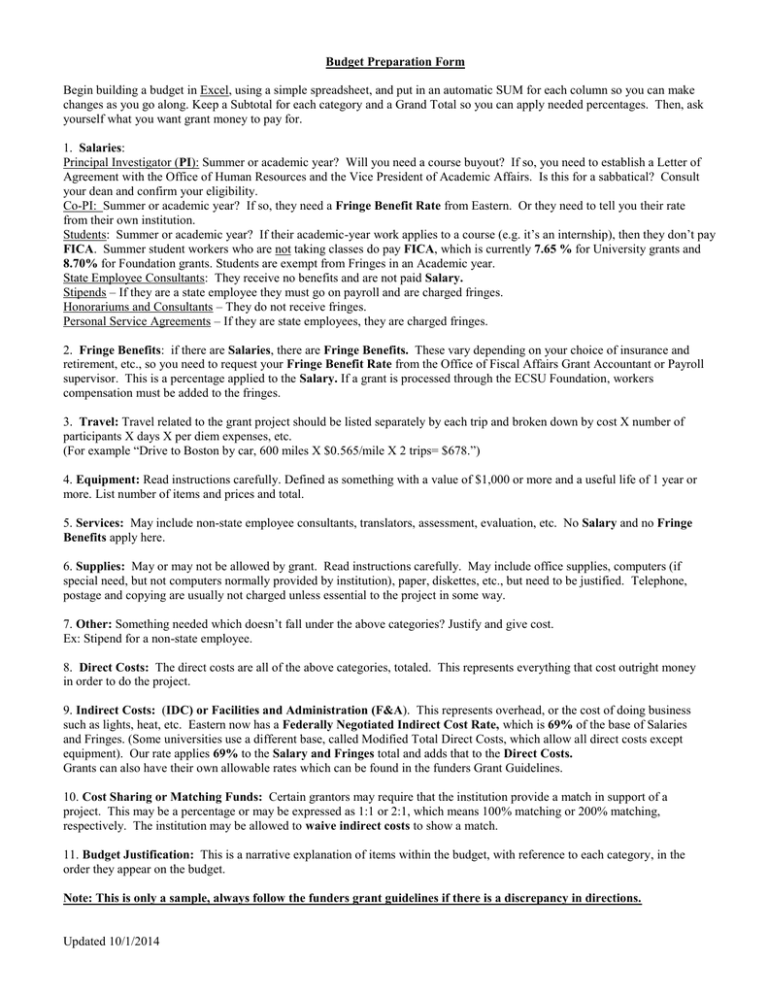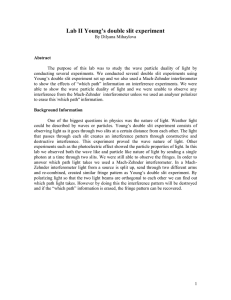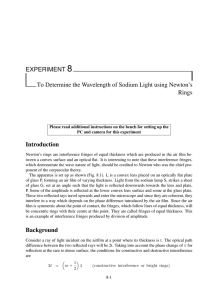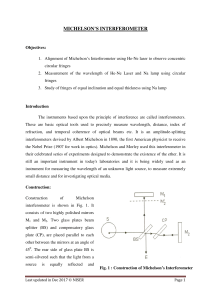Budget Preparation Form
advertisement

Budget Preparation Form Begin building a budget in Excel, using a simple spreadsheet, and put in an automatic SUM for each column so you can make changes as you go along. Keep a Subtotal for each category and a Grand Total so you can apply needed percentages. Then, ask yourself what you want grant money to pay for. 1. Salaries: Principal Investigator (PI): Summer or academic year? Will you need a course buyout? If so, you need to establish a Letter of Agreement with the Office of Human Resources and the Vice President of Academic Affairs. Is this for a sabbatical? Consult your dean and confirm your eligibility. Co-PI: Summer or academic year? If so, they need a Fringe Benefit Rate from Eastern. Or they need to tell you their rate from their own institution. Students: Summer or academic year? If their academic-year work applies to a course (e.g. it’s an internship), then they don’t pay FICA. Summer student workers who are not taking classes do pay FICA, which is currently 7.65 % for University grants and 8.70% for Foundation grants. Students are exempt from Fringes in an Academic year. State Employee Consultants: They receive no benefits and are not paid Salary. Stipends – If they are a state employee they must go on payroll and are charged fringes. Honorariums and Consultants – They do not receive fringes. Personal Service Agreements – If they are state employees, they are charged fringes. 2. Fringe Benefits: if there are Salaries, there are Fringe Benefits. These vary depending on your choice of insurance and retirement, etc., so you need to request your Fringe Benefit Rate from the Office of Fiscal Affairs Grant Accountant or Payroll supervisor. This is a percentage applied to the Salary. If a grant is processed through the ECSU Foundation, workers compensation must be added to the fringes. 3. Travel: Travel related to the grant project should be listed separately by each trip and broken down by cost X number of participants X days X per diem expenses, etc. (For example “Drive to Boston by car, 600 miles X $0.565/mile X 2 trips= $678.”) 4. Equipment: Read instructions carefully. Defined as something with a value of $1,000 or more and a useful life of 1 year or more. List number of items and prices and total. 5. Services: May include non-state employee consultants, translators, assessment, evaluation, etc. No Salary and no Fringe Benefits apply here. 6. Supplies: May or may not be allowed by grant. Read instructions carefully. May include office supplies, computers (if special need, but not computers normally provided by institution), paper, diskettes, etc., but need to be justified. Telephone, postage and copying are usually not charged unless essential to the project in some way. 7. Other: Something needed which doesn’t fall under the above categories? Justify and give cost. Ex: Stipend for a non-state employee. 8. Direct Costs: The direct costs are all of the above categories, totaled. This represents everything that cost outright money in order to do the project. 9. Indirect Costs: (IDC) or Facilities and Administration (F&A). This represents overhead, or the cost of doing business such as lights, heat, etc. Eastern now has a Federally Negotiated Indirect Cost Rate, which is 69% of the base of Salaries and Fringes. (Some universities use a different base, called Modified Total Direct Costs, which allow all direct costs except equipment). Our rate applies 69% to the Salary and Fringes total and adds that to the Direct Costs. Grants can also have their own allowable rates which can be found in the funders Grant Guidelines. 10. Cost Sharing or Matching Funds: Certain grantors may require that the institution provide a match in support of a project. This may be a percentage or may be expressed as 1:1 or 2:1, which means 100% matching or 200% matching, respectively. The institution may be allowed to waive indirect costs to show a match. 11. Budget Justification: This is a narrative explanation of items within the budget, with reference to each category, in the order they appear on the budget. Note: This is only a sample, always follow the funders grant guidelines if there is a discrepancy in directions. Updated 10/1/2014






